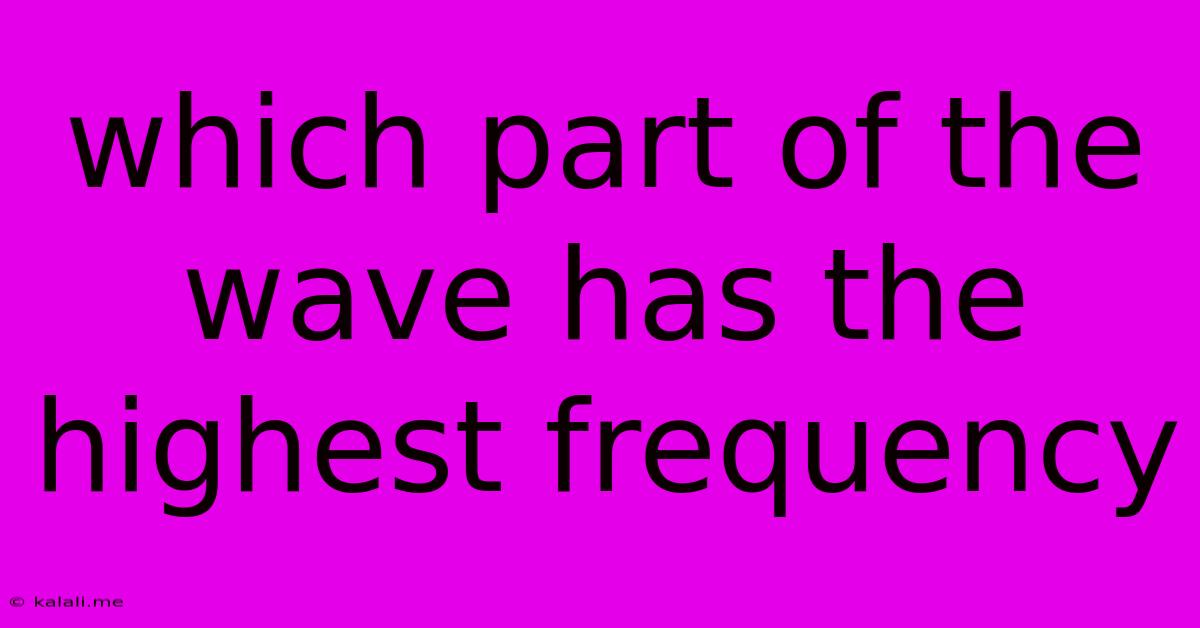Which Part Of The Wave Has The Highest Frequency
Kalali
Jun 13, 2025 · 2 min read

Table of Contents
Which Part of the Wave Has the Highest Frequency? Understanding Frequency and Wavelength
Understanding waves, whether they're sound waves, light waves, or water waves, requires grasping the relationship between frequency, wavelength, and amplitude. While amplitude refers to the height of the wave, and wavelength the distance between two consecutive crests (or troughs), frequency refers to how many wave cycles pass a given point per unit of time. This means that all parts of a wave have the same frequency.
This is a crucial point often misunderstood. A single, continuous wave doesn't have varying frequencies across its length. The frequency is a characteristic of the entire wave, not a specific part. Think of it like this: if you're counting cars passing a point on a highway, you're counting the rate of cars, not focusing on individual aspects of each car. The frequency is that rate.
Frequency vs. Wavelength: An Inverse Relationship
The concept of wavelength helps clarify the misunderstanding further. Wavelength (λ) and frequency (f) are inversely proportional, related through the wave speed (v): v = fλ. This means that for a given wave speed, a higher frequency corresponds to a shorter wavelength, and a lower frequency corresponds to a longer wavelength.
But this doesn't mean that the shorter wavelength part of the wave has a higher frequency. The entire wave, from crest to trough, propagates with the same frequency. The shorter wavelength simply implies that more cycles are packed into a given distance.
Examples: Sound and Light Waves
Let's illustrate with examples:
-
Sound Waves: A high-pitched sound has a high frequency, meaning many sound waves pass your ear per second. The wavelength of this high-frequency sound is short. A low-pitched sound, conversely, has a low frequency and a long wavelength. Both sounds, however, possess a uniform frequency throughout their propagation.
-
Light Waves: Visible light is an electromagnetic wave. Violet light has the highest frequency and shortest wavelength in the visible spectrum, while red light has the lowest frequency and longest wavelength. But again, each color of light maintains a consistent frequency across its entire wave structure.
Key Takeaway
To reiterate, no part of a wave has a higher frequency than another. The frequency is an inherent property of the entire wave, determined by the source generating it. While wavelength varies inversely with frequency, this variation applies to the entire wave, not individual segments within it. Understanding this fundamental principle is essential for comprehending wave phenomena in physics and related fields.
Latest Posts
Latest Posts
-
Able To Be Drawn Into Wire
Jun 14, 2025
-
Which Of The Following Statements Is True Regarding
Jun 14, 2025
-
What Is The Least Common Multiple Of 20 And 40
Jun 14, 2025
-
Temple University Japan Campus Acceptance Rate
Jun 14, 2025
-
Which Of The Following Is Not An Aspect Of Globalization
Jun 14, 2025
Related Post
Thank you for visiting our website which covers about Which Part Of The Wave Has The Highest Frequency . We hope the information provided has been useful to you. Feel free to contact us if you have any questions or need further assistance. See you next time and don't miss to bookmark.